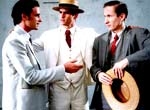 “Nuestro objetivo final es nada menos que lograr la integración del cine latinoamericano.
Así de simple, y así de desmesurado”.
“Nuestro objetivo final es nada menos que lograr la integración del cine latinoamericano.
Así de simple, y así de desmesurado”.
Gabriel García Márquez
Presidente (1927-2014)


-

Capricho lezamiano en El viajero inmóvilPor Rubén Padrón AstorgaTomás Piard estrenó una película dedicada a José Lezama Lima. Tipo enigmático, resistente a las clasificaciones, tupido y fantasmagórico como sus libros, equívoco, impenetrable e inverosímil, está Lezama a kilómetros de ser un personaje fácil de biografiar.
Lezama era un acróbata de las palabras. Las cambiaba de lugar, las obligaba a saltar por el aire, a caer por el suelo. Las estrujaba o las estiraba para que exhibieran formas caprichosas y sonidos insólitos. Les extirpaba sus usos comunes y les hacía decir cosas estrafalarias. Las martirizaba, las deformaba, eligiendo nuevas combinaciones, a riesgo de que repelieran con su nuevo aspecto, de que espantaran incluso. Lezama no buscaba la belleza ni la comunicación. No buscaba siquiera la fealdad o el hermetismo. Manierista, (1) Lezama buscaba otra cosa; algo raro, caprichoso (2) y retorcido, que encontraba poniendo en tensión a las palabras. Estas sustituyen al objeto, tienen en sí mismas fuerza creadora y retuercen lo que encuentran a su paso. Por eso cuesta tanto seguirle la pista, entenderlo, incluso disfrutarlo. Un árbol torcido es atractivo no tanto como árbol, sino como forma extraña. Vale la pena demorarse a contemplarlo, porque los ojos se complacen en seguir sus líneas extravagantes, como gritos desgarradores de la forma. Pero cámbiese a todos los árboles sus troncos rectos, y se sentirá el hastío de lo descomunal, de lo incomprensible, de lo afectado y de lo feo. Lezama es el árbol torcido en el bosque uniforme. Es el árbol irreverente que elige su destino sin darle la menor importancia a la opinión vulgar. Lezama es el árbol distinto e indiferente.
Intentar reproducir a Lezama, intentar imitarlo, es evadirlo. En principio la película no trata de reproducirlo y por eso se vale de su novela y no de su poesía. Paradiso es historia, es ficción narrada. Adaptar Paradiso es evitar el inútil empeño de reproducir siempre a Lezama para explicarlo. Pero ocurre que en El viajero inmóvil no hay tal adaptación, pues no se nos narra una historia. Es más bien un punto en que se hace confluir a Lezama con su novela, para contemplarlos juntos. Paradiso es una novela autobiográfica, y he aquí el buen camino que escogió la película. Sin embargo, se detiene en la contemplación del estilo lezamiano, y en reverenciarlo.
La película está llena de cosas caprichosas. ¿Pero cómo llegar a Lezama de otra forma? Está claro. Sin capricho, sin afectación, no hay Lezama. Sin embargo, este método, que ha sido ya intentado infinitas veces por ensayistas y teóricos, ha demostrado que así solo se obtiene medio Lezama, tal vez su mitad más lezamiana, pero la menos biográfica. Al reproducirlo, al llevarlo a la síntesis, se obtiene su esencia pero se pierde el hombre, que se desfigura. Este sacrificio que se hace del hombre para obtener su esencia es la base de toda teoría. Sin esencia no hay teoría. Sin embargo, cuando se construye la teoría, se hace ineludible desteorizar, es decir, verter el descubrimiento sobre el sujeto original. Encontrada la esencia de Lezama, una vez que el hombre ha sido lezamianizado, ¡por Dios!, hay que deslezamianizarlo, porque si no, la esencia se desfigura, se esfuma y se desaprovecha. Una vez descubierto el funcionamiento espiritual del hombre, hay que ver su funcionamiento vital a la luz de lo descubierto. Hay que poner a vivir al hombre.
Lezama era un tipo raro. Hay muchas anécdotas que lo ilustran, empezando por la forma en que vivía, encerrado en su calle Trocadero con sus fantasmas. A Lezama le encantaba caminar, pero le tenía terror a los espacios abiertos. Le encantaba reunirse con sus amigos, enseñar y aprender de los jóvenes, de los inexpertos, de los «iniciados», como él les llamaba. Le gustaba impresionar a los eruditos, y para eso no le importaba valerse de exageraciones o de invenciones suyas. A la esposa de un embajador la invitó a tomar cierto té, que él le pintó como bebida finísima traída de Oriente, de sabor y olor exquisitos, cuando en realidad lo había comprado ese mismo día, porque no tenía otra cosa que brindarle, en la farmacia de su barrio. Y la mujer se fue encantada. A un ilustre señor alemán que le visitó le recitó una larga lista de escritores alemanes de segunda clase, que conocía al dedillo, y dejó boquiabierto a su visitante. Tal vez no todos eran escritores, ni alemanes, pero Lezama no concebía la existencia sin un poco de juego y de fabulación. Cuando enseñaba a sus discípulos, se convertía en un maestro riguroso, estricto y pesado. Los hacía leer una y otra vez los libros hasta que los entendían. Y pobre del que no los leyera, pues sabía que perdía automáticamente la estima del maestro. Sin embargo, Lezama fue un hombre sencillo, que vivió con lo poco que tenía. Sus libros no siempre se editaron. No tuvo hijos, aunque tal vez los hubiera deseado tener. Su asma no lo dejaba vivir, en una época en que no existían las medicinas que hoy existen para combatirla. Tuvo demasiados enemigos, más de los que un hombre como él hubiera merecido.
Se sabe sobre su vida, pero se sabe, sobre todo, porque se interpreta a la luz de sus textos. Sin el descubrimiento de la esencia lezamiana sería imposible comprender a este señor extraño, que escribió libros impenetrables y que vivió de una forma inaudita. Si se le comprende un poco más, es porque el sentido de sus textos se ha buscado en las zonas oscuras de su vida, en sus exageraciones, en el amaneramiento de sus ideas, en su forma singular de expresarse. Pero desgraciadamente esta búsqueda se encuentra regada en la multitud de textos que sobre él se han escrito. No hay un solo libro, hasta donde conozco, que nos muestre a Lezama como era, que nos traiga a Lezama hasta nosotros, pues todos se empeñan en llevarnos a nosotros hasta él.
El cine es un instrumento muy eficaz para fabricar biografías. Poco hace falta para lograrlo; tan poco, que lo que menos hace falta es solemnidad, que es el peor enemigo de las biografías. Hay que arrastrar al hombre hacia la biografía y dejarlo tras sus rejas, por muy mal que le siente. Si sale mal parado, peor para él. Mejor para los demás. El viajero inmóvil se acerca a la biografía. De hecho es más un documental que una película de ficción. Si así fuera, esa sería para mí su mayor virtud; a saber, haber renunciado al encanto de la ficción para aterrizar a Lezama en el suelo frío de la realidad. Pero la película se siente demasiado atraída por Paradiso y su realidad se vuelve fantasmagórica y muy poco fría. Siente demasiado encanto por Lezama y lo deja escapar.
De cualquier forma, fue bueno su empeño. Y mucho mejor la plasticidad, la finura con que está hecha. Sus personajes tienen vida, a pesar de haber tenido que asumir la difícil faena de vivirla en esa zona dudosa entre el documental y la ficción, entre la vida de Lezama y su libro Paradiso. De hecho, se ve el asombro en sus caras de personajes venidos de otro cuento, pero tienen vida y son convincentes al expresarla. Para hacerse oír no tienen que gritar, para hablar no siempre necesitan decir palabras, pues para eso están los ojos, que no lo dicen todo porque para eso están las palabras. Son personajes delicados y sensibles, que se mueven en su mundo sin estar frenéticamente pendientes del mundo de los demás.
Traer a Lezama hasta nosotros se convierte así en tarea pendiente para nuestro cine. El viajero inmóvil lo ha intentado y eso es ya algo valioso. Lo sorprendente es que no se haya hecho antes. El próximo paso tendrá que ser atrapar a Lezama en su viaje y pedirle cuentas.
1. Me refiero al movimiento artístico que fue antecedente e inspirador del barroco, y que fue definido por Arnold Hauser en su extraordinario libro El manierismo.
2. Caprichoso en su sentido artístico, es decir, cuando la obra de arte se sirve del ingenio o de la fantasía para romper la observancia de las reglas. Es en este sentido en el que está utilizado en el artículo.
 Caprice Lezama´s way in El viajero inmóvil
Caprice Lezama´s way in El viajero inmóvil
By Rubén Padrón Astorga
Tomás Piard released a film dedicated to the Cuban writer José Lezama Lima. Enigmatic fellow, resistant to the classifications, dense and phantasmagoric as his books, ambiguous, impenetrable and unimaginable, Lezama is far from been an easy subject for a biography.
Lezama was an acrobat of words; he changed their place, and forced them to fly and to fall to the ground. He crumpled and stretch them so that they showed fanciful shapes and unbelievable sounds. He removed words common use and made them say weird things. He also tormented and twisted them out of shape, choosing new combinations, risking that they were rejected or even frightened with their new aspect. Lezama did not consciously find beauty or communication, and neither ugliness or inscrutability.
Lezama, a mannerist (1), looked for something different, something odd, capricious (2) and convoluted, which he managed putting the words in tension. They replace the object and have creative force in themselves, twisting everything they find in their way. That is why is so difficult to follow Lezama’s track, to understand him, even to enjoy him. A lopsided tree is attractive not much as tree but as a weird shape. It is worth to stop and gaze at it because the eyes take pleasure in following its bizarre lines, as a heartrending cries of its shape. But try to change the straight trunk to all the trees, and you will feel the tedium of the colossal, the incomprehensible, and the ugly. Lezama is the twist tree in the uniform forest. Is the irreverent tree that chooses its own destiny without taking account of the vulgar opinion. Lezama is the different and indifferent tree.
Try to reproduce and imitate Lezama is to depart from him. In principle the film does not attempt to imitate him and that is why uses his novel and not his poetry. Paradiso is a story, is a narrated fiction. To adapt Paradiso is to avoid the always useless effort of reproducing Lezama in order to explain him. But it happens that in El viajero inmovil there is no such adaptation, because not a story is told to us. The film is closer to the meeting point of Lezama´s life and novel brought together to be commonly contemplated. Paradiso is an autobiographical novel, hence this is a good election made by the film. Nevertheless the film lingers on the contemplation of and the reverence to Lezama’s style.
The film is full of fanciful things. But, is there another way to discover Lezama? It is clear. Without fancy, there is no Lezama. However this method, which has just been attempted many times by essayists and theorists, has just demonstrated that is only able to show one half of Lezama, maybe the nearest to Lezama as an author, but the least biographic. In reproducing and synthesizing Lezama the author, his essence is obtained but the man is lost, whose features in turn are distorted. To sacrifice the man to obtain his essence is the based of all theory. Without essence there is no theory. However, once that theory is built, it is unavoidable to depart from theory, or what is the same, use its essence to reflect the original individual. Once the essence of Lezama has been found, once that the man has become Lezama the author, for God’s sake, the man Lezama has to be demystified as Lezama the author, if not, this essence is distorted, vanished, and wasted. Once discovered the spiritual functioning of man, it is necessary to see his vital functioning considering what it has been discovered. It is necessary to put the real man in motion.
Lezama was a strange guy. There are many anecdotes to show it, including the way he lived, confined with his ghosts on his Trocadero Street. Lezama loved to walk but was afraid of the open spaces. He also loved to meet his friends, to teach and learn from young people, the inexperienced, the “initiated” as he called them. He liked to impress the experts, and to do that, he did not mind to use exaggerations or his own inventions. Once he invited an ambassador´s wife to drink some tea that he praised as a very fine drink brought from the East with an exquisite flavor and smell. The reality was that he had bought it just the same day, because he has not anything to offer, the woman was delighted. Another time Lezama enumerated to an illustrious German visitor a long list of second category German poets, of which he knew the smallest details, the man was astonished. Maybe the names he mentioned were not of poets and neither German, but Lezama did not conceive life without a little of game and fantasizing. When he taught his disciplines, he became a rigorous, strict and tedious teacher. He obliges them to read the books one and again until they understand them and poor souls the ones who did not read them, they lost their teacher´s esteem. However, Lezama was not an ambitious man; he lived with the few possessions he had. Not all his books were published. He had no children even when he wanted to have them. His asthma made his life uneasy, in a time where there was no such medicine as today to fight it. He had many enemies more than a man like him would have deserved.
We know about his life, but this knowledge comes mainly from his texts. Without the discovery of Lezama´s essence will be impossible to understand this odd man who wrote impenetrable books and lived in an unbelievable way. If we understand him a little better is because his book senses have been searched in the darkness of his life, in his exaggerations, in the affectation of his ideas, in his particular way to express himself. But unfortunately this search is dispersed in the many texts that have been written about him. There is not a book, so far as I know, that shows Lezama how he really was, that approach Lezama to us, all of them try to approach us to him.
The movie is a very useful tool to design biographies. Few things are necessary to fulfill it, but anything is less necessary than solemnity, the worst enemy of biographies. The real man must be put behind the bars of his biography, not matter how inconvenient it may be for him, if the results is not positive for the figure, worst for him, best for the others. El viajero inmóvil approaches biography. In fact is closer to a documentary than to a fiction film. If really were so, it would be for me the film´s greatest virtue, i.e. to renounce to the charming of fiction to show Lezama close to the harsh reality of life. But the film feels so much attracted by Paradiso and its reality turns phantasmagoric and away from harsh reality. The feels is so much dazzle by Lezama that lets him escape.
Any way, the effort was good, and much better the plasticity, the refinement with which the film was made. Its characters are alive, in spite of having the difficult task of living their lives in that doubtful zone between the documentary and the fiction; between Lezama´s life and his book Paradiso. In fact, we can see the astonishment in their faces of characters come from another story, but they are alive and are convincing when expressing their lives. To make them heard they do not need shout, to talk they do not have to say anything, because there are the eyes, which in turn do not say everything because there are the words. The film characters are delicate and sensible, they moved in their own world without frenetically devoting their attention to the lives of the rest of the people.
To approach Lezama to us become a pending subject for our cinema. El viajero inmóvil has tried to do that and that is something valuable and what is surprising is that it has not been attempt before. The next step has to be to catch Lezama in his journey and call him to account.
1. I refer to the artistic movement that was an antecedent and inspired the Baroque, and which was defined by Arnold Hauser in his extraordinary book the Mannerism.
2. Fancy in his artistic sense, i.e., when the work of art uses the ingenuity and the fantasy to break the obedience to the rules. It is in this sense that is used in this article.
















